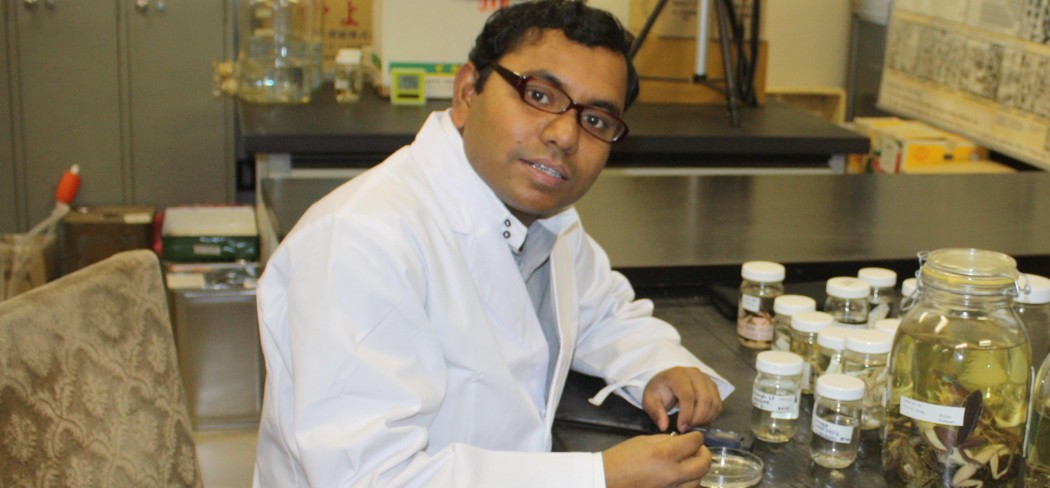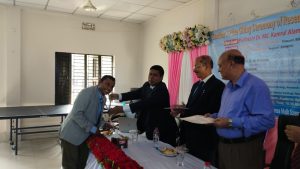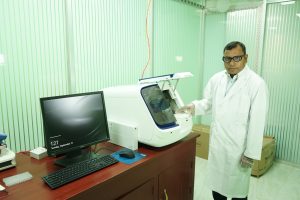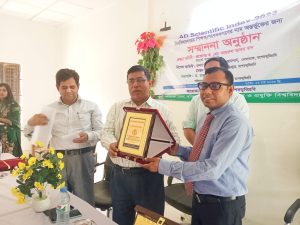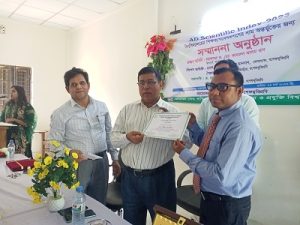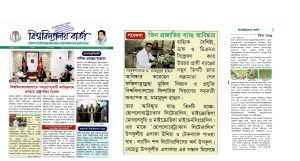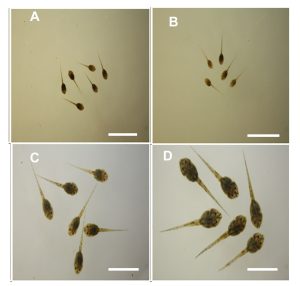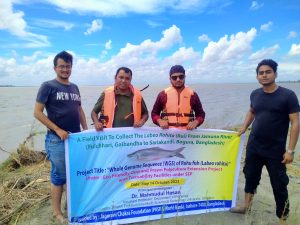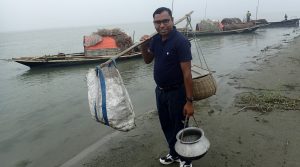Bangamata Sheikh Fojilatunnesa Mujib Science and Technology University, Jamalpur-2012, Bangladesh had organized a research publications fair on April 03, 2023. Based on expert evaluation I became 1st in the faculty of “Biology and Agriculture”. Later on December 7, 2023, university authority handover medal, 10,000 BDT and a certificate. The picture shows that our honorable Vice Chancellor presented medal to me. I am honored and inspired to do further more research work.
Install the “Genetic Analyzer” to Evolution and Diversity Research Laboratory, BSFMSTU
One of the finest and sophisticated machines for gene sequencing “Genetic Analyzer” was recently setup at “Evolution and Diversity Research Laboratory”, BSFMSTU to open the horizon of genomic research in biological science. Honorable Vice Chancellor Prof. Dr. Md. Kamrul Alam Khan Sir inaugurated this machine in last September 11, 2023. This is a milestone to extend the molecular research in our university. University Grants Commission of Bangladesh (UGC) funded to purchase this machine.
Figure: Dr. Mahmudul Hasan is operating the Genetic Analyzer
Receive Research Grant Cheque from BSFMSTU Research Cell, September 20, 2023
Bangladesh is a great delta formed by three mighty Himalayan rivers: the Ganges, the Brahmaputra and the Meghna. Moreover, landscape of Bangladesh is almost flat except eastern areas, but its biogeographic realms divided by international borders (India by the West, East & North and Myanmar by the south-eastern) affect the floral and faunal diversity in a drastic manner. A transboundary river is a river that crosses at least one political boarder, either a border within a state or an international boundary. There are more than 400 rivers in Bangladesh. Out of them only 54 are transboundary rivers (54 shares with India and 3 shares with Myanmar). Most freshwater fishes have an innate tendency to move across long riverine distances without the restriction of any political boundaries. However, the equitable sharing of biological resources, especially for ichthyofauna, is often affected in transboundary riverine systems. Hence, the estimation of spatial diversity and conservation of biodiversity elements in transboundary regions are a major cause of concern for protecting the biodiversity wealth of any country. Fishes from transboundary rivers of north-eastern area in Bangladesh seem unexplored using integrative taxonomy approaches i.e. molecular, morphology, meristic and ecology data. To unveil the hidden biodiversity of fishes from the transboundary rivers, proposed research is initiated to make a error free, accurate freshwater species list in Bangladesh.
Figure: Received a cheque of 915 USD (FY 2023-2024 Research Project) from Honorable Vice-Chancellor of BSFMSTU.
Receive 1st position crest and certificate from the honorable VC Sir of BSFMSTU (March 23, 2023). This position evaluated based on AD Scientific Index 2022 & 2023.
My recent visit at Nagahama Institute of Bio-Science and Technology, Shiga Prefecture, Japan
Recently, I have visited (12-17th November, 2022) Nagahama Institute of Bio-Science and Technology University, Shiga Prefecture, Japan. I presented recent status and prospect of herpetology and ichthyology research in Bangladesh. A few collaborative research work plans have been shared and discussed with top level scientists in Japan.
My research focused on Bangamata Sheikh Fojilatunnesa Mujib Science and Technology University Magazine (July 2022, 1st year, 1st Volume)
Our university (BSFMSTU) has planned to release magazines twice in a year. In connecting this, recently the authority first time published the magazine and focused my achievement and research activities in its first page. This is a thrilling and happiness issue for me which really pursue me to devote more myself further in research work. Thanks to university authority.
Postmating isolation and evolutionary relationships among Fejervarya species from Lesser Sunda, Indonesia and other Asian countries revealed by crossing experiments and mtDNA Cytb sequence analyses (Accepted in Ecology and Evolution Journal, Sep 30, 2022)
To evaluate the degree of postmating isolation and the evolutionary relationships among frog species in the genus Fejervarya from Indonesia (Lesser Sunda), Bangladesh, China, and Japan, crossing experiments and molecular phylogenetic analyses were carried out. Crossing experiments revealed that reciprocal hybrids among F. iskandari, F. verruculosa, and F. sp. large type and between F. multistriata and F. kawamurai are viable through metamorphosis, while those between the F. iskandari group and F. limnocharis group were completely or partially inviable at the tadpole stage and those between Southeast Asian and South Asian Fejervarya groups were completely inviable at the embryonic stage. The mature reciprocal hybrids between F. iskandari and F. verruculosa from Lesser Sunda, Indonesia showed some degree of abnormality in spermatogenesis. In phylogenetic analyses based on mtDNA Cytb sequences, F. iskandari formed a sister clade with F. verruculosa from Lesser Sunda, Indonesia with 8.1% sequence divergence. F. multistriata from China formed a clade with populations of F. limnocharis in Thailand, Malaysia, and Indonesia (topotype) and these taxa showed sister relationships to F. kawamurai from Japan with 8.9% sequence divergence. Fejervarya sp. small type from Bangladesh formed a clade with the other South Asian members of the Fejervarya group and formed a sister clade with the Southeast Asian Fejervarya group, with 23.1% sequence divergence in the Cytb gene. These results showed that the degree of postmating isolation reflects molecular phylogenetic relationships and that F. iskandari and F. verruculosa from Indonesia (Lesser Sunda) are reproductively isolated by abnormalities in spermatogenesis and show genetic differentiation.
Figure. Twenty-day-old tadpoles of the hybrids and the controls among the Fejervarya from Asia. (A) Fkaw ♀ × Fisk ♂(K), (B) Fkaw ♀ × Fisk ♂ (E), (C) Fkaw♀ × Fkaw ♂, (D) Fmul ♀ × Fkaw ♂. Scale bar = 10 mm.
Collection of Labeo rohita (Rui) fish from the Jamnua river, Ghotail, Islampur, Jamalpur, Bangladesh
Figure: We are on the islands of the Jamuna River.
Recently, I along with my undergraduate students went to the Jamuna river for Rui fish collection. This was a terrible experience in the middle of the river. Because, the tide and wave was so strong that we were merely escaped from the danger. We finally achieved to catch two Rui fishes from the help of fishermen. Our target is to know the Whole Genome Sequence of Rui fish from the biggest river in Bangladesh like the Jamuna. This project was funded by Gagaroni Chakra Foundation, Jashore, Bangladesh.
Small research grant received from the Bangamata Sheikh Fojilatunnesa Mujib Sci & Tech Uni research cell FY 2020-2021
Figure: Trying to catch the fish as well as adapt with the targeted fishermen life style.
The Brahmaputra drainage system has been originated from the Manasarovar Lake region, near the Mount Kailash, located on the northern side of the Himalayas in Burang County of Tibet, China. Later it enters into Arunachal Pradesh, India and flows southwest through the Assam Valley as Brahmaputra. Then, it enters into Bangladesh through Kurigram district and divided into two parts near to Dewangonj (Northen part of Jamalpur district): 1) the Brahmaputra (also known as old Brahmaputra) and the Jamuna River. Warm water temperatures, plentiful rainfall, and nutritive silty clay-loam soil make the Brahmaputra drainage system is big resources for icthyofauna in Bangladesh. But many species are now under threat due to unsustainable fishing practices, invasive species, and habitat alteration and loss. In addition, anthropological activities pose thereat of the entire ecosystem in Bangladesh. Therefore, sustainable management of the aquatic resources of the region is urgently needed to conserve the icthyofauna. A prerequisite for this is a careful and accurate assessment of fish species to measure suitable conservation policy for the targeted species.
